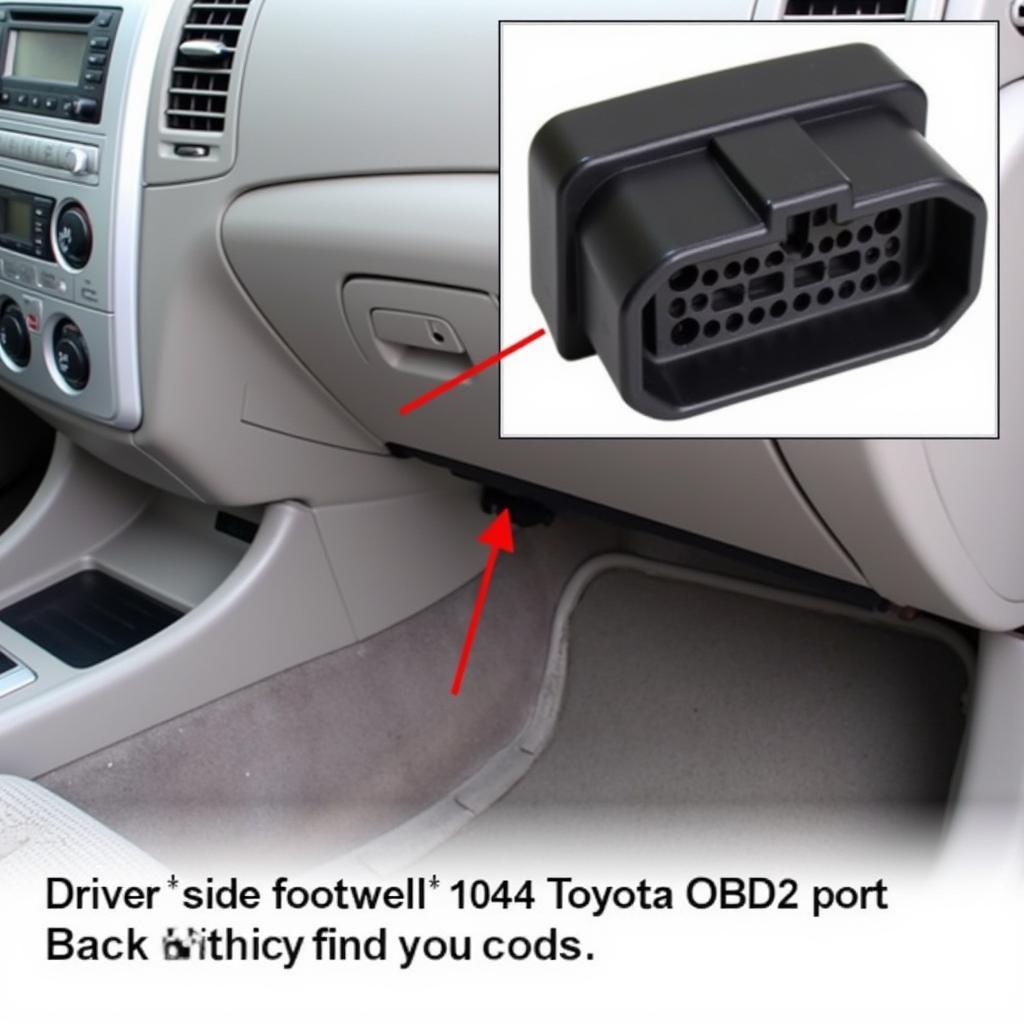If you’re a 2004 Toyota Corolla owner looking to delve into the world of DIY car diagnostics, knowing the location of your OBD2 port is the first step. This article acts as your guide to easily locating and understanding the OBD2 port on your 2004 Toyota Corolla.
A standard across most modern vehicles, the OBD2 port, or On-Board Diagnostics port, acts as your car’s data center. It allows you to connect a device, like an OBD2 scanner, to read your car’s computer, retrieve diagnostic trouble codes (DTCs), monitor performance data, and even clear error codes.
Locating the OBD2 Port on Your 2004 Toyota Corolla
In most cases, the OBD2 port is located on the driver’s side of the vehicle, beneath the dashboard, and typically within reach of the steering wheel. Here’s a more specific guide for your 2004 Toyota Corolla:
- Sit in the driver’s seat and look beneath the steering column towards the dashboard.
- Visually scan the area for a trapezoidal-shaped 16-pin connector. It often has a cover that may need to be opened.
- The connector may be partially obscured but should be relatively easy to locate.
Note: While the location described above is standard for most 2004 Toyota Corollas, there can be slight variations depending on the specific trim level and model. If you’re having trouble finding it, consult your owner’s manual.
Common Issues Related to the OBD2 Port in a 2004 Toyota Corolla
Even though the OBD2 port is a reliable component, you might encounter a few common issues. Understanding these can be helpful:
- Loose or Damaged Pins: Over time, the pins inside the port can become bent, broken, or corroded. This can prevent a secure connection with your scanner.
- Blown Fuses: The OBD2 port’s functionality is linked to your car’s electrical system. A blown fuse can disrupt the power supply to the port, making it non-functional.
- Wiring Problems: In rare cases, damaged or frayed wiring leading to the OBD2 port can cause connection issues.
Beyond Finding the Port: Using Your OBD2 Port Effectively
Knowing the location of your OBD2 port is just the start. Connecting a compatible OBD2 scanner opens a world of possibilities:
- Diagnose Engine Problems: Read and interpret DTCs to pinpoint the root cause of your check engine light.
- Monitor Performance: Track real-time data like speed, RPM, engine temperature, and fuel economy.
- Customize Your Driving Experience: Some advanced scanners allow you to adjust certain vehicle settings.
- Turn Off Warning Lights: After addressing an issue, you can use the scanner to clear error codes and turn off warning lights.
Expert Insight
“Understanding the basics of your car’s OBD2 system can empower you as a car owner,” says Emily Carter, Senior Automotive Technician at Carter’s Garage. “With an OBD2 scanner, you can be more proactive about your car’s maintenance and even troubleshoot minor issues before they become major headaches.”
Conclusion
Locating the OBD2 port on your 2004 Toyota Corolla is a simple task that can have significant benefits. This easily accessible port is your gateway to understanding your car’s health and performance. Whether you’re a DIY mechanic or simply want to be more informed about your vehicle, being able to connect to your OBD2 port is an invaluable asset.
FAQs
1. What does OBD2 stand for?
OBD2 stands for On-Board Diagnostics, generation 2. It’s a standardized system that allows external devices to communicate with your car’s computer.
2. Is my 2004 Toyota Corolla OBD2 compliant?
Yes, all 1996 and newer vehicles sold in the United States, including your 2004 Toyota Corolla, are OBD2 compliant.
3. What can I do if I can’t find my OBD2 port?
Double-check the areas mentioned in this guide, consult your owner’s manual, or search for images specific to your Corolla’s model and trim level online.
4. Can I leave an OBD2 scanner plugged in all the time?
While it’s typically safe to leave a scanner plugged in for short periods, it’s best to unplug it when not in use to prevent battery drain.
5. Where can I get help understanding the data from my OBD2 scanner?
Numerous online resources, forums, and user manuals are available to help you interpret OBD2 data. You can also consult with a trusted mechanic.
Need further assistance? Our team at OBDFree is always ready to assist you. Feel free to reach out to us via WhatsApp: +1(641)206-8880 or Email: [email protected]. We are available 24/7 to answer your queries and provide expert guidance. For additional information and resources, browse through our website for more insightful articles and helpful tips.


